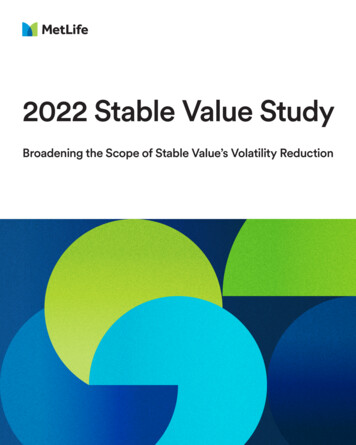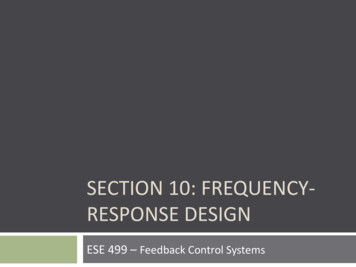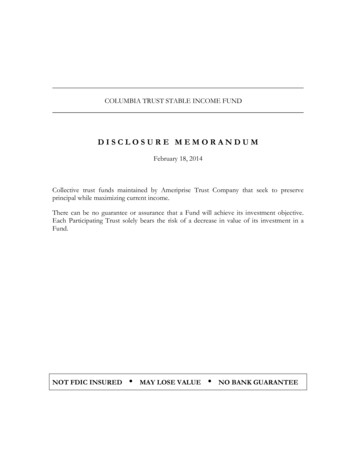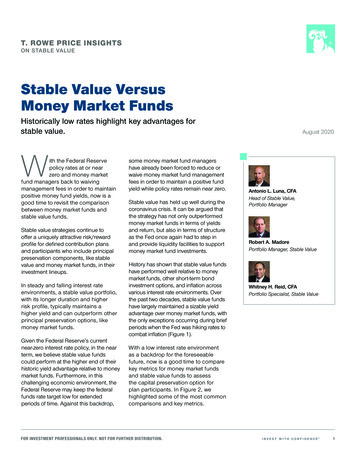
Transcription
2022 Stable Value StudyBroadening the Scope of Stable Value’s Volatility Reduction
TABLE OF CONTENTSIntroductionp. 02Study findingsp. 03Conclusionp. 19Methodologyp. 21
2022 Stable Value StudyINTRODUCTIONFor defined contribution (DC) plan sponsors, the primary objectives of DC plan designand management are understanding their plan participants’ long-term savings andinvestment goals and helping them achieve retirement income security. Because planparticipants have very different financial circumstances, selecting plan investmentoptions that best serve the largest number of participants is challenging. Having DCplan solutions that are designed to help mitigate the effects of volatility is also critical —especially for those nearing or already in retirement, who typically have a low risktolerance and a limited time horizon to recover from market losses.In this fifth study that MetLife commissioned to gain strategic insight into the use ofstable value in DC plans, MetLife has broadened the scope of the study beyond stablevalue as a capital preservation option. The study also explores stable value’s potentialto optimize returns, while minimizing volatility, in target date funds (TDFs).Capital Preservation in DC PlansAs one of the leading issuers of stable value solutions, MetLife believes it is importantto continually assess plan sponsors’ attitudes toward stable value as a capital preservationoption. Stable value, which is offered in eight in 10 DC plans, is an investment option designedto offer plan participants the greatest total return consistent with protection of principal.The 2022 Stable Value StudySM revisits plan sponsors’ selection of stable value as acapital preservation option, as well as the frequency with which advisors recommendstable value to their plan sponsor-clients. The study also reviews perceptions aboutstable value’s performance, including how it compares to that of money market funds.By contrasting perceptions to actual historical performance, the study shows that stablevalue, which is the only capital preservation option designed specifically for qualifiedretirement plans, has consistently given plan participants significantly greater returnsthan money market funds.Return and Volatility Management in TDFsIn this latest study, MetLife also focuses on the views of DC plan sponsors and advisorsabout the tradeoffs between return and risk and, as TDFs increasingly dominateDC plan investment lineups, the potential of stable value to optimize risk/return inthe TDFs they offer.In addition to the insights obtained by surveying DC plan sponsors and advisors, we alsogained perspective on capital preservation options and market volatility strategies fromstable value fund (SVF) providers.2
2022 Stable Value Study3STUDY FINDINGSViews on DC plan capital preservationStable value continues to be widelyoffered to plan participantsStable value has long been a cornerstone of 401(k) and other workplace retirement plans(i.e., 403(b) and 457 plans). Today, eight in 10 DC plan sponsors (82%) offer stable valueas a capital preservation option, including a third who offer both stable value and moneymarket. Most plan sponsors that offer stable value first started offering stable valuemore than five years ago, and nearly all (98%) say they are not planning to make anychanges to their stable value offering.Stable value has long been a cornerstone of 401(k) and otherworkplace retirement plans (i.e., 403(b) and 457 plans).The use of money market funds has declined significantly since 2015, with less than halfof sponsors (48%) offering money market as a capital preservation option today (downfrom 52% in 2017 and 62% in 2015). Of those offering money market funds, very few offermoney market funds on their own (15%); more than double (33%) offer money marketalongside stable value.Capital preservation options offered by plan sponsorsNetNet MMFs:MMFs: 48%48%49%49%33%33%15%15%Net StableStable Value:Value: 82%82%NetStableStableValueValueBoth StableStable ValueValueBothandMMFsand MMFsMoneyMoneyMarket FundsFundsMarketOtherOther capitalcapitalpreservationpreservation optionsoptions3%3%
2022 Stable Value StudyPlan sponsors and their advisorsclosely align on why stable value is thepreferred capital preservation optionWhen looking at why companies offer stable value, almost all stable value fund providers(91%) say it is stable value’s better returns compared to those of money market funds andother capital preservations options, and nearly half say that advisor recommendations(45%) are the primary reasons. Among the advisors that recommend stable value, nearlyall (90%) cite stable value’s superior performance compared to money market funds.Among plan sponsors who offer stable value, 82% say that it was recommended by theiradvisors, and 64% cite that recommendation as a top reason for offering stable value.Whether stable value was recommended as a capital preservation optionDon’tknowNo10%82%8%of plan sponsors say stablevalue was recommendedby their plan advisor82%Yes4
2022 Stable Value Study5Top reasons for offering/recommending stable valueRecommended by investment/f inancial advisorN/A64%Better returns than MMFs or other capital preservation options44%90%Recommended by recordkeeper or TPA15%20%Requested by employees8%20%Requested by employersN/A18%Other4%3%Plan sponsorsPlan advisorsNote: Multiple responses were permittedOf the advisors who recommend money market funds, only 12% say they do so becausethey believe money market funds offer greater returns than stable value — despite thefact that stable value has consistently outperformed money market. Similarly, only 9%of plan sponsors who offer money market funds only also believe that money marketfunds outperform stable value. Among plan sponsors who offer money market funds,76% say that it was recommended by their advisor, and 60% say that was the primaryreason for their selection. The 60% result is up 14 percentage points from the 46% in2017, suggesting that advisors yield significant influence with plan sponsors in theirinvestment option selection.
2022 Stable Value Study6Financial strength ratings top thelist of considerations when decidingwhich stable value solution to offerWhen considering which stable value solution to select, plan sponsors cite thefinancial strength rating of issuers (91%), fee levels (88%) and the rate that is creditedto plan participants (82%) as a very or extremely important consideration. Nearlynine in 10 advisors (89%) also cite the financial strength rating of the issuer as avery or extremely important factor when considering which stable value solution torecommend, followed by crediting rate (80%) and fee levels (68%) — with financialstrength rating most commonly being the most important factor.Important factors for plan sponsors when selecting stable value solutions% of those stating this is extremely or very importantFinancial strength rating of stable value contract issuer91%Fee levels88%Rate that is credited to the plan participants82%Diversification by investment manager of underlying portfolio68%Diversification by stable value contract issuer60%Available contract terms56%Having input into changesto the investment guidelines29%
2022 Stable Value StudyFor plan sponsors, diversification by investment manager(s) of the underlyingasset portfolios (72%) is much more important than diversification by stable valuecontract issuer(s) (28%).Diversification importancePlan sponsors28%72%Plan advisors39%61%Diversification by stable value contract issuer(s)Diversification by investment manager(s) of the underlying asset portfoliosWhile 53% of plan sponsors say their documentation for the selection of their capitalpreservation option includes a quantitative analysis of the return and risk characteristicsof different capital preservation options, fewer plan providers and advisors (45% and37%, respectively) believe that a majority of their clients have documentation supportingtheir decision about their plans’ capital preservation option(s).7
2022 Stable Value Study8Plan sponsors split on offeringstable value individually or througha pooled fundAdvisors say their clients are evenly split between offering stable value throughindividual and pooled stable value options but slightly more plan sponsors (49%) areoffering stable value through pooled funds than individually (40%). There has been aslight increase in sponsors offering stable value through pooled funds in the last fiveyears (49% today, up from 42% in 2017), while offering stable value individually hasdeclined (40% today, down from 48% in 2017).How stable value is providedIndividual stable value account managed by a stable value manager27%32%Net Individual: 40%vs. 48% in 2017Individual stable value accountnegotiated directly with providersNet Individual: 45%8%18%Through a recordkeeper’s proprietary stable value pooled fund27%Through a stable value pooled fundunbundled from the recordkeeper16%Don’t knowPlan sponsors10%11%Plan advisors20%30%Net Pooled: 49%vs. 42% in 2017Net Pooled: 43%
2022 Stable Value Study9Advisors who have clients with individually managed solutions are using a variety of stablevalue contract types. These include general account, separate account, and syntheticcontracts. General account contracts are group annuity contracts that credit a specifiedinterest rate for a defined period of time. The contract is an asset of the plan or trustand is backed by the contract issuer’s general account. General account contracts arenon-participating, as the credited rate is guaranteed regardless of the actual investmentexperience of the general account or the amount or timing of participant withdrawals.Separate Account GICs are group annuity contracts where the contract liabilities aresupported by insurance company separate accounts. These separate accounts aresegregated from the insurer’s general account and are for the beneficial interest of thoseparticipating in the separate account. Like the assets of a general account, the assetsof insurer separate accounts are owned and managed by the insurer and may be subadvised by one or more third-party investment managers selected by the insurer.With Synthetic GICs, the qualified plan trust owns and holds the underlying investedassets supporting the stable value fund. The plan sponsor enters into separate contractswith asset managers and wrap providers.Plan advisors: Products in individually managed stable value offeringsAmong those whose clients have individual structuresGeneral account contract19%58%17%6%Separate account guaranteed interest contract8%64%22%6%Synthetic guaranteed interest contract8%Very often44%Sometimes36%SeldomNever11%
2022 Stable Value StudyThe target date fund landscapeDefined contribution plan sponsorsare concerned about market volatility,especially for participants near — orin — retirementWith target date funds increasingly dominating DC plan assets, ensuring TDFinvestors’ assets are adequately protected from market volatility is critical toretirement income security.Those already in retirement are the most vulnerable to the impact market volatility canhave on their portfolio as they try to balance investment growth with protection fromvolatility. Older workers, particularly those within 10 years of retirement, can also besignificantly negatively impacted by volatility because of the short time horizon theyhave to recover from losses in their portfolio.When plan sponsors were asked about their level of concern regarding the abilityof DC plan participants to mitigate the impact of market volatility, many expressedconcern — particularly for those already retired or approaching retirement. Seven in 10plan sponsors (70%) are concerned about the impact of market volatility on retirees, 67%are concerned about those within 10 years of retirement and 52% are concerned aboutthose more than 10 years away from retirement.When plan sponsors were asked about their level of concernregarding the ability of DC plan participants to mitigate the impactof market volatility, many expressed concern — particularly forthose already retired or approaching retirement.10
2022 Stable Value Study11Plan sponsor concerns around participants’ ability to weatherimpact of market volatilityThose 10 years from retirement31%21%48%52%Those within 10 years of retirement21%46%33%67%Those in edNot tooconcernedDonˇt know4%
2022 Stable Value Study12Plan advisors and plan sponsorsexpress concern about the impactof market volatility on participantretirement outcomesMore than half of plan sponsors (55%) and 61% of advisors are very concerned aboutfuture market volatility impacting plan participants’ retirement outcomes, and 49%of plan sponsors and 71% of advisors believe that market volatility is a top concern ofplan participants.Sentiment around market volatilityYour company’s retirement plan has sufficient investment options to help mitigate market volatility67%You are very concerned about future market volatilitynegatively impacting plan participants’ retirement outcomes55%61%Market volatility is a top concern of your plan participants49%When market volatility occurs, you spend a significantamount of time calming down participants21%Plan sponsorsPlan advisors57%71%94%
2022 Stable Value Study13While many plan sponsors think their company sufficiently educates participants aboutmitigating and/or handling the impact of market volatility, three-quarters think moreeducation is needed. Advisors agree on the need for more participant education but areless likely to think their clients are currently doing a good job. Sponsors of plans withhigher assets under management (AUM) and more participants are more likely to agreetheir company does a good job in educating plan participants on the need to ride outmarket volatility.Sentiment around market volatility educationPlan participants need more education around how to handle market volatility73%Your company does a good job in educating plan participants on theneed to ride out market volatility70%49%Your company does a good job in educating plan participantsapproaching retirement on strategies to mitigate market volatility31%Plan sponsorsPlan advisors61%88%
2022 Stable Value StudyPlan sponsors are more likely thanadvisors to think TDF allocationsshould be more conservative forthose near and in retirementTDFs take retirement investment decision-making out of the hands of DC plan participantsby using a set-it-and-forget-it approach. An important consideration when a TDF isconstructed is the mix of equities and fixed income for various participant age cohorts.When plan sponsors and advisors were asked if TDF portfolios should be 50/50(i.e., 50% equity/50% fixed income), more aggressive, or less aggressive for variousparticipants categories, 71% of plan sponsors and 47% of plan advisors thoughtportfolios should be less aggressive for those in retirement.An important consideration when a TDF is constructed is the mixof equities and fixed income for various participant age cohorts.Similarly, plan sponsors have concerns about the TDF equity allocations for those within10 years of retirement. However, there appears to be a disconnect between plan advisorsand their plan sponsor-clients for this cohort: 67% of plan advisors think their TDF portfoliosshould be more aggressive versus only 29% of plan sponsors who feel this way.Additionally, the survey found that nearly one in five plan sponsors (18%) are likely tosay that it is very or somewhat common for plan participants to delay retirement due toexperiencing market losses in their TDFs.14
2022 Stable Value StudyCompanies report greater economiesof scale when retirees keep money inthe DC planPlan sponsors report that a median of 40% of DC plan participants keep their assetsin the plan after retirement, and half say their TDFs are intended for participants tostay within the same fund after retirement. This finding that retirees remain in the planhighlights the need for TDFs to be structured to best meet their need to address theimpact of market volatility.Among plan sponsors whose participants keep assets in the plan after retirement,many say this increases economies of scale and reduces costs for their DC plan. Thisis cited by six in 10 plan sponsors (62%). Larger plans (those with more than 5,000 planparticipants and those with 100M or more) are more likely to report higher percentageskeeping money in plan post retirement (median 50%, each).Among plan sponsors whose participants keep assets in the plan afterretirement, many say this increases economies of scale and reduces costsfor their DC plan.15
2022 Stable Value StudyPlan sponsors would be interested inincreasing equity in TDF glidepaths ifthe impact of market volatility couldbe minimizedWhen asked if their firm has implemented or considered investment strategies tomanage the impact of market volatility in their TDFs, only 12% of plan sponsors haveimplemented and 8% are considering implementing market volatility strategies — eventhough 58% of plan advisors have recommended or considered recommending TDFvolatility management strategies. These strategies range from diversification of assetclasses to the inclusion of stable value and fixed income options.Seven in 10 plan sponsors (71%) would be interested in adding an increased level ofequity in their TDFs glide path to enhance returns if the impact of market volatility couldbe mitigated, including 21% who would be extremely or very interested.16
2022 Stable Value Study17Interest is aligned on features that canreduce volatility and enhance returnsAlthough few TDFs today include strategies to reduce volatility with the ability toenhance returns, which are principles of stable value, there appears to be significantinterest in solutions that can do both. Today, plan sponsors are fairly evenly split whenasked whether reducing volatility while maintaining returns, or improving returns whilemaintaining current level of volatility, is more important in optimizing target date funds.However, both plan advisors and fund providers gravitate toward smoothing out volatilitymore than improving returns (65% versus 35% and 64% versus 36%, respectively).Although few TDFs today include strategies to reduce volatility withthe ability to enhance returns, which are principles of stable value,there appears to be significant interest in solutions that can do both.TDF providers: volatility vs. returnsPlan sponsors47%53%Plan advisors65%35%64%36%Plan providersSmooth out volatility, while maintaining current level of returnsImprove returns, while maintaining current level of volatility
2022 Stable Value StudyHowever, when given a more specific example of how this works in practice, interestgrows considerably. For example, if the TDF provider could utilize a solution thatgenerates net returns four times more than the cost associated with delivering thoseincremental returns (e.g., 60 basis points enhanced net returns for a cost of 15 basispoints) while keeping volatility constant, 89% of plan sponsors and 97% of advisorswould be interested in this feature. There is also significant interest — 86% of plansponsors and 94% of plan advisors — in a feature that could maintain comparablereturns, net of fees, while reducing volatility by approximately 40%.Few custom TDFs offered but interestappears to be growingTo ensure that TDFs meet the needs of plan participants, the Department of Laborhas said that ERISA plan fiduciaries should “inquire about whether a custom or nonproprietary target date fund would be a better fit for [their] plan ” Despite the DOL’ssuggestion, most plan sponsors or advisors select off-the-shelf TDFs, which may notbe the best fit for the plan’s participants.To ensure that TDFs meet the needs of plan participants, the Departmentof Labor has said that ERISA plan fiduciaries should “inquire aboutwhether a custom or non-proprietary target date fund would be a betterfit for [their] plan ”Although relatively few companies have a TDF that has been constructed for them, theuse of custom TDFs may grow in the future. One in four advisors (27%) are consideringrecommending or constructing custom TDFs for their plan sponsor-clients, and overhalf of plan sponsors without a custom TDF say they would be motivated to considera custom TDF based on their advisors’ recommendation. For advisors, volatility anddissatisfaction with off-the-shelf TDFs would be the top motivators for consideringcustom options. Directionally, the study also found that 41% of plan sponsors and 75%of plan advisors who are concerned about custom TDFs being more expensive wouldbe willing to explore the benefits of a custom TDF to see if they outweigh the costs.11Small base18
2022 Stable Value StudyCONCLUSIONStable value is an important component of DC plans. With approximately 902 billioninvested in stable value assets, it is the only capital preservation option designedspecifically for DC plans and the only investment option that enables participants totransact at “book” value regardless of the market value of the underlying securities.Book value, also called contract value, means the contributions made, plus accruedinterest, minus previous withdrawals or transfers. For 45 years, stable value funds haveperformed exceptionally well in all market conditions and have provided participantswith a safe haven in times of significant market volatility. In prior periods of marketvolatility, and both rising and falling interest rates, this asset class has performed asdesigned and consistently delivered on its primary DC plan investment objectives:capital preservation with a reasonable rate of return. With eight in 10 plan sponsorsoffering stable value as a capital preservation option, stable value will continue toplay an important role in helping participants achieve the greatest total return for theirretirement savings consistent with protection of principal.For the large majority of plan participants invested in TDFs, which are professionallymanaged asset allocation portfolios that are designed to take the guesswork out ofinvesting and encourage investors to stay invested for the long term, it is important thatplan sponsors ensure that these participants will be able to balance investment growthwith protection from market volatility. While off-the-shelf TDFs have been the mostpopular version, custom TDFs may be better suited to offer solutions that help mitigatethe impact of volatility. With a quarter of advisors considering recommending orconstructing custom TDFs for their plan sponsor-clients, and over half of plan sponsorswithout a custom TDF saying they would be motivated to consider a custom TDF basedon their advisors’ recommendation, custom TDFs are likely to become increasingly moreprevalent in the future.Regarding the impact of market volatility, more than half of plan sponsors and six in 10advisors are very concerned about future market volatility impacting plan participants’retirement outcomes. Half of plan sponsors and seven in 10 advisors believe that marketvolatility is a top concern of plan participants. To mitigate the effects of volatility, plansponsors and advisors are interested in adding features to TDFs that significantly lowervolatility while maintaining returns or, conversely, enhancing returns while maintainingvolatility. When given specific examples of how this works in practice, interest growsconsiderably. For example, if the TDF provider could utilize a solution that generatesnet returns four times more than the cost associated with delivering those incrementalreturns (e.g., 60 basis points enhanced net returns for a cost of 15 basis points) whilekeeping volatility constant, 89% of plan sponsors and 97% of advisors would beinterested in this feature. There is also significant interest — 86% of plan sponsors and94% of plan advisors — in a feature that could maintain comparable returns, net of19
2022 Stable Value Studyfees, while reducing volatility by approximately 40%. By having their TDF providersadopt volatility reduction features, plan sponsors and their participants will be betterpositioned in retirement.Stable value will continue to be a mainstay of DC plans. And, as the DC plan marketplacehas moved to more of a set-it-and-forget-it approach with TDFs, so too has the abilityfor the longstanding volatility smoothing principles of stable value to be applied increative ways for those TDFs. This approach enables TDF providers to optimize the risk/return profile of their TDFs for the benefit of plan participants. Whether stable value isused as a standalone DC plan capital preservation option or as a tool to manage volatilityin target date funds, one thing is certain: DC plan participants will be well positioned toachieve retirement income security.20
2022 Stable Value Study21METHODOLOGYMetLife commissioned Greenwald Research to conduct surveys of plan sponsors,advisors and stable value fund providers between June and October 2021. A totalof 222 interviews were completed among plan sponsors who offer a 401(k), 457 or403(b) plan. Assets under management for plans included in the study ranged fromunder 10 million to over 1 billion. Each respondent had to work for a company thatoffers a DC plan with TDFs or target risk options, offer a capital preservation option,and have at least a moderate amount of influence over decisions regarding stablevalue or related funds for their company’s defined contribution plan(s). Online surveyswere also completed by 49 DC plan advisors and 11 stable value fund providers.Metropolitan Life Insurance Company 200 Park Avenue New York, NY 10166Metropolitan Tower Life Insurance Company 5601 South 59th Street Lincoln, NE 68516L0122019324[exp0123][All States][DC] 2022 MetLife Services and Solutions, LLC
When looking at why companies offer stable value, almost all stable value fund providers (91%) say it is stable value's better returns compared to those of money market funds and other capital preservations options, and nearly half say that advisor recommendations (45%) are the primary reasons. Among the advisors that recommend stable value .










